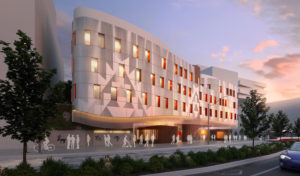Construction has begun at the Anishnawbe Health Toronto Indigenous Community Health Center in the Canary district of Toronto. The four-story, 45,000 square foot building is being constructed in recognition of Canada’s National Indigenous Peoples Day. The facility has been designed by Stantec who collaborated with the Indigenous-owned Two Row Architect on the design of the center, which will unite services from three locations under one roof to centralize and improve access to health care for the city’s Indigenous communities. The CAD$33.6 million facility will combine Indigenous and Western approaches, complemented by social and cultural programs, to serve Indigenous groups in the Toronto area.
Also Read: CAMH opens two new buildings in Toronto, Canada
The ground floor will be home to key programs like the sweat lodge, Traditional Healer, ceremonial space, and the community kitchen. Each of the facilities will be established as standalone pavilions inspired by pebbles in a stream. Since art is an important part of storytelling and Indigenous culture the design weaves art into the building fabric through interior glass panels displaying patterns and artwork chosen by the community. The central red staircase is inspired by ‘the red road’; an Indigenous metaphor speaking to the idea of making wise and spiritual choices in life.
The central landscaped courtyard, rising 21 feet from street level and accessible from the first and second floor of ICHC, is unique and emblematic of a land-inspired approach. At the heart of the development, it connects people and places with a walking path surrounded by native plants of tobacco, sage, cedar, and sweetgrass surrounding seven benches representing the seven grandfather teachings: wisdom, love, respect, bravery, honesty, humility, and truth. Meshed with the path is a meandering bioswale collecting rainwater for irrigation. “It was an honor to contribute to a new and much-needed layer of Indigenous culture and presence within the urban fabric of the city,” said Michael Moxam, design culture practice leader for Stantec.
98

